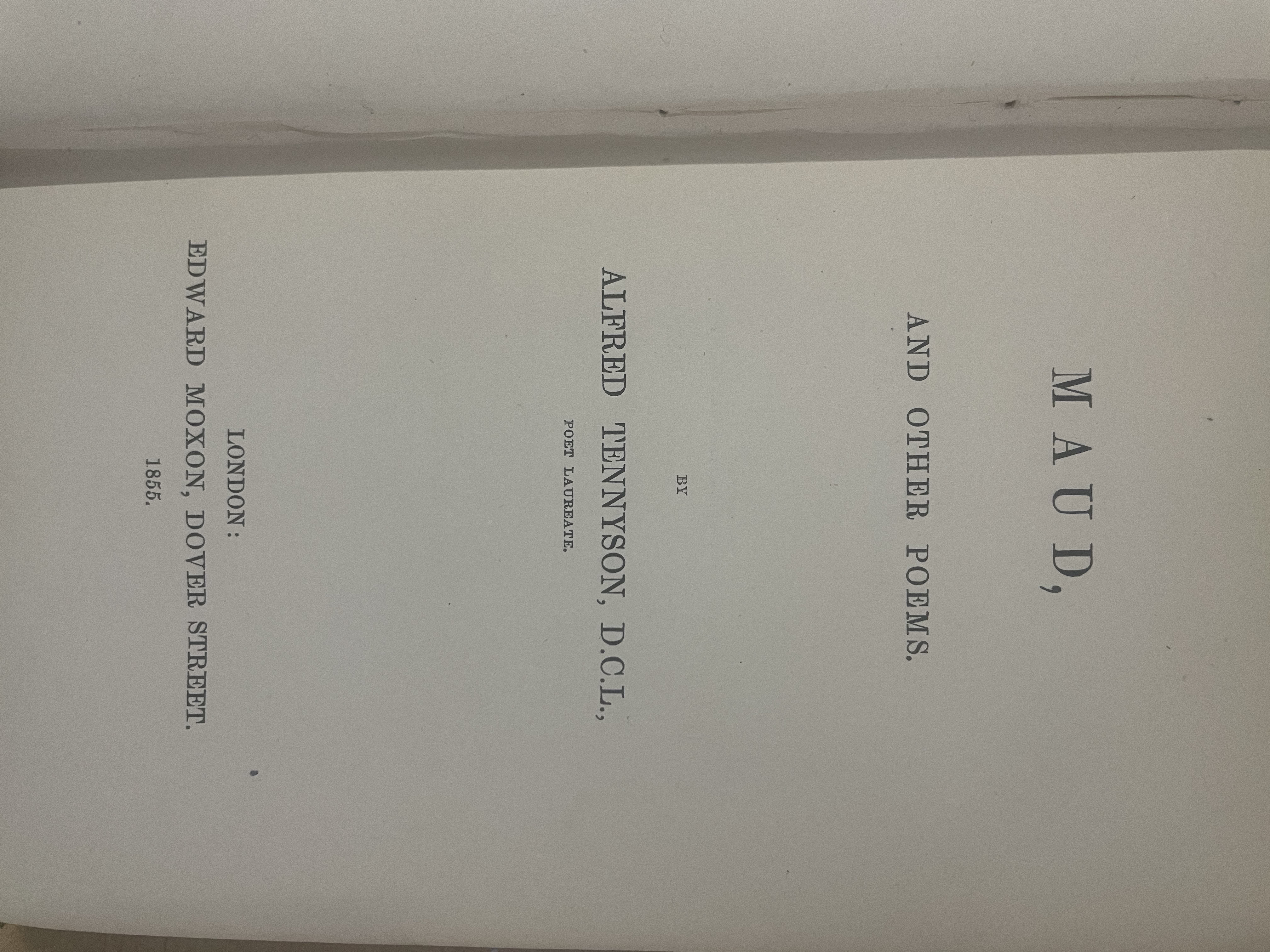Maud and other Poems

About
Summary
Exquisite
TOC
Details
Related
URL
Images
Overview
Alfred Tennyson's Maud, and Other Poems, published in 1855, is a collection that encapsulates the Victorian era's anxieties, sensibilities, and artistic innovations. The centerpiece, Maud, is a complex and controversial monodrama that explores themes of love, loss, madness, and social critique through the voice of an unstable narrator. The collection also includes other notable poems, such as The Charge of the Light Brigade, which commemorates the bravery of soldiers during the Crimean War.Maud, and Other Poems is a diverse collection that showcases Tennyson's lyrical mastery and his engagement with the pressing issues of his time. The collection can be broadly divided into two parts: the title poem Maud, a long narrative sequence, and a selection of shorter, more varied poems.
Importance of Book
Psychological Depth: Maud is notable for its exploration of the complexities of the human psyche. Tennyson delves into the mind of a disturbed narrator, capturing his shifting moods, his irrational thoughts, and his struggle to make sense of the world around him.
Social Commentary: The collection offers a critique of Victorian society, exposing its flaws and contradictions. Tennyson challenges the prevailing values of materialism, social conformity, and imperial ambition, raising questions about the direction of English society.
Innovative Form: Maud is a groundbreaking work in its use of the dramatic monologue form. Tennyson experiments with voice, perspective, and structure to create a poem that is both intensely personal and broadly social.
Lyrical Beauty: The collection showcases Tennyson's mastery of language and his ability to create memorable and evocative imagery. His poems are characterized by their musicality, their emotional intensity, and their visual richness.
Key Themes
Love and Loss: The collection explores the transformative power of love and the devastating consequences of loss. Maud traces the narrator's journey from isolation and despair to ecstatic love and, ultimately, to profound grief and madness.
Social Critique: Tennyson critiques the materialistic values, social inequalities, and moral hypocrisy of Victorian society. The narrator of Maud rails against the corruption and greed that he sees around him, lamenting the loss of traditional values and the rise of a commercial culture.
Madness and Sanity: The poem delves into the complexities of the human mind, exploring the boundaries between sanity and madness. The narrator's descent into madness reflects his inability to cope with personal tragedy and social injustice. His eventual recovery suggests the possibility of healing and redemption, but also raises questions about the nature of sanity and the role of social forces in shaping individual consciousness.
War and Patriotism: The Crimean War serves as a backdrop for the collection, raising questions about the nature of heroism, the costs of war, and the meaning of national identity. The Charge of the Light Brigade celebrates the bravery of soldiers but also hints at the futility and waste of war. The narrator's decision to join the war effort at the end of Maud suggests a desire for personal and social regeneration through sacrifice and service.
Nature and the Human Psyche: Tennyson uses vivid imagery of nature to reflect the narrator's emotional states and to explore the relationship between the individual and the natural world. The garden in Maud serves as a symbol of both idyllic love and the potential for destruction.
Cultural Significance
Maud, and Other Poems is a significant cultural artifact that reflects the anxieties and aspirations of the Victorian era. The poem's themes of social critique, psychological turmoil, and the search for meaning resonated with readers who were grappling with the rapid changes and challenges of the time. The collection also reflects the Victorian interest in medievalism, evident in the chivalric style of the love-poem which is combined with a contemporary cynicism. Tennyson's exploration of these themes helped to shape the cultural conversation of the Victorian era and continues to resonate with readers today. The poem reflects the contentious issues of identity, intellect, and modernity.
Effects on Society
Maud, and Other Poems had a mixed reception upon its publication. Some critics praised Tennyson's lyrical genius and his willingness to tackle difficult subjects. Others criticized the poem's morbid tone, its complex structure, and its perceived lack of patriotism. Despite the controversy, the collection sold well and helped to solidify Tennyson's reputation as one of the leading poets of the Victorian era.
The poem's exploration of madness and psychological distress may have contributed to a greater understanding and awareness of mental health issues in Victorian society. Its critique of social inequality and materialism may have influenced social reformers and activists who were working to address these problems. The poem's engagement with the Crimean War may have shaped public opinion about the conflict and the costs of empire.
Tennyson was known to recite the poem in its entirety on social occasions. The poem was met with much criticism in contemporary circles.
Tennyson returns to the poetry of sensation, and dwells on a consciousness constituted of fragments of feeling. He deliberately denies an autonomous voice, and the ending is deeply ironic.
Maud keeps at its center the symbol of the reconstruction of the human personality; it traces a similar movement from isolation to social acceptance.
Conclusion
Maud, and Other Poems is a complex and multifaceted work that offers a window into the Victorian era's anxieties, aspirations, and artistic innovations. Through the voice of a troubled narrator, Tennyson explores themes of love, loss, madness, and social critique, challenging readers to confront the difficult questions of their time. The collection's lyrical beauty, psychological depth, and social commentary have made it a lasting contribution to English literature, securing Tennyson's place as one of the most important poets of the Victorian era.
Title
Maud and other Poems
Author
Baron Alfred Tennyson
Name of Publisher
Edward Moxon Dover Street London
Publish Date
1855
Subject
Tennyson?s poetic range and thematic concerns during the mid-19th century
Vintage
1801-1900
Edition
First
Number of Pages
154
Category
Literary
Sub Category
Poetry
Rarity
RARE
